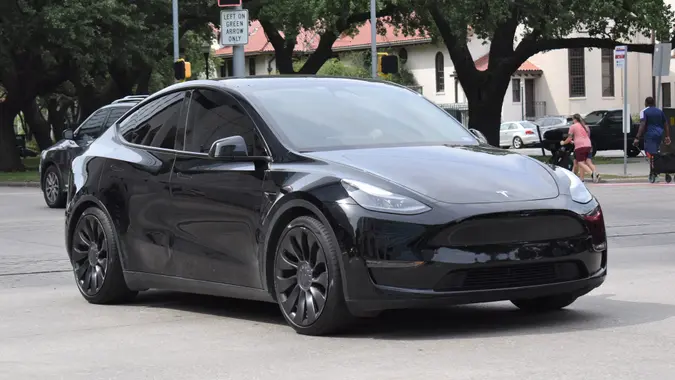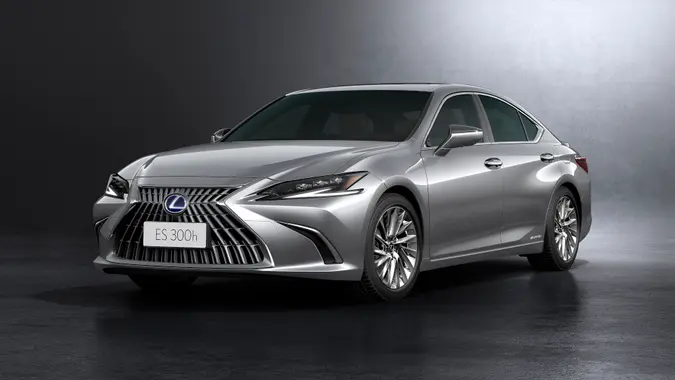5 Hidden Tesla Costs That Could Drain Your Wallet

Commitment to Our Readers
GOBankingRates' editorial team is committed to bringing you unbiased reviews and information. We use data-driven methodologies to evaluate financial products and services - our reviews and ratings are not influenced by advertisers. You can read more about our editorial guidelines and our products and services review methodology.

20 Years
Helping You Live Richer

Reviewed
by Experts

Trusted by
Millions of Readers
There are many reasons to consider getting an electric car. It’s environmentally friendly, you’ll save money on fuel over the years and there’s typically less maintenance than vehicles with internal combustion engines.
However, some downsides aren’t immediately clear. If you scour the internet, netizens are quick to point out the hidden costs of owning EVs such as Teslas. Here are five things to keep in mind.
Higher Initial Price
Currently, buying a Tesla off a car lot costs more than a gas-powered equivalent. Both Honda Accords and Tesla Model 3s are popular mid-size sedans. A 2025 Honda Accord has a price range of $28,295 to $39,300, according to Edmunds, while a 2025 Tesla Model 3 is significantly more expensive at $42,490 to $54,990.
With that said, the price gap is coming down. Per InsideEVs, in 2021, there was a 50% difference in price between an EV and an internal combustion engine (ICE) vehicle. This dropped to 15% by 2023.
Battery Replacement
While it’s not a guarantee that you’ll need to replace your Tesla battery, having to do so is expensive. Tesla batteries have limited warranties based on the type of vehicle you drive. For example, a Model S has a warranty period of eight years or 240,000km, while a New Model Y Rear-Wheel Drive has eight years or 160,000km.
If your battery dies outside of the warranty period, you might be stuck with a high cost. A battery replacement for a Model S may be in the range of $20,000 to $22,000, with the battery and labor costs totaled together.
Insurance
In general, EVs cost more to insure than ICE vehicles, which may surprise some shoppers. The National Association of Insurance Commissioners (NAIC) reported that EV insurance can be $44 more expensive per month than ICE insurance. The most expensive EVs to insure are Tesla’s Model 3 and Model Y cars.
The higher insurance premiums stem from three main reasons, according to Experian. The higher initial price of an EV means the insurer will have to pay more to replace the car. Second, while EVs usually require less maintenance than gas-powered vehicles, when they do require maintenance, it’s usually extensive and very costly. Finally, the rapid rise in popularity of EVs means sales are outpacing labor, so it can cost more to get replacement parts or maintenance.
Registration Fees
Another overlooked cost of owning a Tesla is the registration fees. Gas-powered vehicles pay taxes when they buy gas, which then goes to improve transportation infrastructure in the area. Because EVs don’t need gas, the government requires owners to pay fees in place of these taxes.
Depending on how much gas you would use or which state you live in, these fees can exceed what you would pay in gas tax. For example, in Texas, first-time EV owners must pay a $400 first-time registration fee, and then registration renewal fees of $200 every year afterward, according to the U.S. Department of Energy.
Tires
EVs use more expensive tires and go through them more quickly than ICE vehicles. EVs are heavier and accelerate faster, meaning their tires wear out 20% faster than their gas-powered counterparts, per CNBC. In addition to the fact that EV owners will need to purchase tires more often, the tires cost 50% more to reduce noise and improve the overall range.
More From GOBankingRates
- Nearly 1 in 3 Americans Hit by a Costly Holiday Scam, Norton Survey Shows -- How To Avoid This
- Here's What Retirees Wasted the Most Money On in 2025 -- and How To Avoid It in 2026
- How Middle-Class Earners Are Quietly Becoming Millionaires -- and How You Can, Too
- 6 Safe Accounts Proven to Grow Your Money Up to 13x Faster
 Written by
Written by  Edited by
Edited by 

























